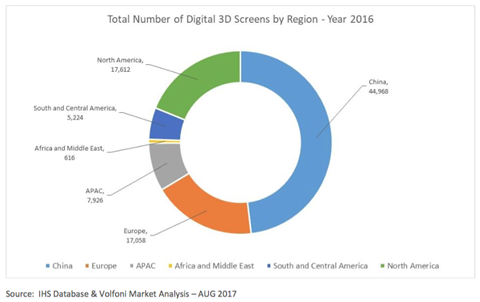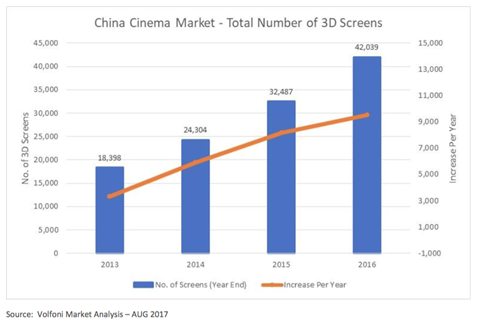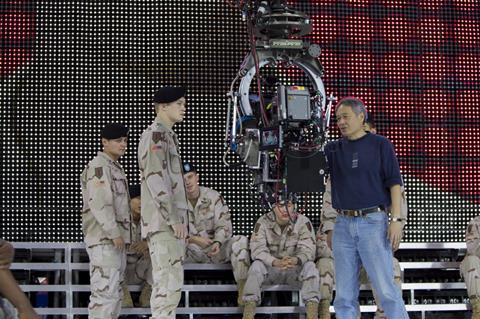3D may have suffered from bad conversions and dim projection, but interest from countries such as China and advances in display technology mean the format’s future is bright, writes Patrick Von Sychowski.

Those who walked the exhibition halls of this year’s IBC will have seen that 3D TV sets have all been replaced by 8K, HDR, VR, AR and other new viewing technologies.
When IMAX announced this summer that it would screen fewer films in 3D, citing a ‘clear preference’ of consumers for 2D, it seemed like yet another nail in the coffin for the stereoscopic format.
But talk to people in the industry and you will soon discover that while 3D might have plateaued in European and North American cinemas, it is still growing strongly in Asia and elsewhere, with new technological improvements set to boost the quality of the experience.
“The demand for 2D films is starting to exceed 3D in North America,” IMAX’s CEO Greg Foster said in a call to investors in July, with films such as Dunkirk only in 2D IMAX. Yet IMAX is not turning its back on 3D, simply scaling it back. Bladerunner 2049, Marvel’s Thor: Ragnarok, WB’s Justice League, Star Wars: The Last Jedi and many more films will be released in 3D both by IMAX and in regular cinemas.
Watch IBC2017 Video
Ben Ritterbush Director Digital Cinema Content 20th Century Fox
”Internationally [3D] is very big… often we will do a 3D release of a movie exclusively for China” - Ben Ritterbush
The 3D contribution of the last Star Wars film Rogue One in the UK alone was £17.6m, which by itself would have positioned the film in 2016’s Top 20 out of over 900 film releases. This is likely to be repeated with The Last Jedi this year.
“I don’t think people go to see movies because they’re in 3D anymore; in the same way they don’t go to see movies because they’re in colour anymore,” said James Cameron, whose 2009 Avatar did more than any other film to drive 3D in cinemas, in a recent Wired interview.
He still firmly believes in 3D. “I think we have a long way to go until [cinema] reaches its full potential,” citing the high dynamic range of Dolby Cinemas as having the potential to “show us what that next level looks like in that cinematic experience.” The first of the three Avatar sequels will open in 2020 - in 3D of course.

David Hancock of IHS Markit points out that while 3D box office seems to have stabilised at around 14% for North America, it still accounts for one-fifth of global box office and even rose in the last year with full data (2015) from 19.7% to 20.7%.
The main explanation for this is China, which accounts for nearly half of all 3D screens in the world (44,986) - more than the combined 3D screens of North America (17,612) and Europe (17,058). Close to 90% of cinema screens in China have 3D capabilities and with 28 new screens opening on average every day that 3D number will just keep growing.
“We are seeing an acceleration in demand in the marketplace for 3D cinema and 3D cinema systems, particularly in markets outside of the traditional western markets,” says Allen Schoonmaker, Chief Marketing Officer at Volfoni 3D, pointing to the so-called BRIC territories, and in China and the Middle East in particular.
“This growth trend is being driven by two primary trends: The move to 3D as a standard in the provisioning of new cinemas, and the continued rise of the ‘premium cinema’ experience.”

The biggest game changer for 3D has been the launch and adoption of RGB laser projection, which creates brighter 3D with richer colours. Previewed at IBC2012 when Christie screened Hugo in 14 foot lamberts, five years later RGB laser completely dominates projector deployments for premium large format (PLF) screens.
Speaking at the installation of the Christie 6P RGB laser at Major Cineplex’s flagship cinema Paragon Cineplex earlier this year, Christie’s General Manager Han Kim noted that it “produces incredible brightness, a reinforced color spectrum and an extraordinary contrast ratio that significantly improves the efficiency of 3D projection systems.”

The use of RGB laser means that even the largest screens can now produce a bright 3D image, which is fuelling a new growth spurt in premium 3D installations. The latest is the plan for India’s largest 3D screen to be constructed in Sullurpeta, which at 106 feet (32.3 meters) will be even larger than the existing IMAX in Hyderabad. 3D is part of the overall premium cinema offerings that also include immersive audio, 4D immersive seating or comfortable recliners.
Volfoni sees this trend strongly outside of China as well, having recently worked with Grand Cinemas in Lebanon and FLIK cinema in Qatar on new premium sites.
“From e-ticketing, e-kiosk, to Platinum and Gold-class multiplexes, these operators deliver a cutting-edge experience to their audiences,” says Volfoni’s Schoonmaker. “As part of the premium experience, these operators require 3D hardware systems that can deliver high LEF performance and compatibility with the latest laser projection technology, as a requirement for their cinemas’ hardware systems.”
When RealD acquired rival MasterImage in early 2017 it also meant an end to the patent war of attrition between the two 3D technology majors that had played out on multiple continents and led to some cinemas holding off on renewing or upgrading their existing 3D systems. Meanwhile Volfoni was acquired by Chinese company Luxin-Rio, which has given it better access to the world’s largest 3D cinema market, as well as financial resources to pursue more R&D to improve the stereoscopic experience further.

Cinema 3D also received a quality boost this year from the launch of Samsung direct view Cinema LED screen, which boasts 4K resolution, 120 fps, high dynamic range and most significantly, light levels in excess of 140 foot lamberts.
This means that the type of heightened reality 3D that was demonstrated by Doug Trumbull’s experimental sci-fi films UFOTOG at IBC in 2014 and Ang Lee’s Billy Lynn’s Long Halftime Walk at IBC2016, which was only possible with dual-stacked special non-cinema projectors, can now be played easily in regular multiplex. The same is expected from Sony’s CLEDIS (crystal LED integrated structure) displays, which could be targeted for the cinema market in the future.
Even IMAX is bullish about the prospects of 3D around the world, despite scaling it back in North America.

Quoted in Cinema Technology magazine, IMAX’s VP of Theatrical Development and MD Europe and Africa, Giovanni Dolci feels that the immersive quality of 3D can be central for the right kind of film. “I believe that 3D can have a very immersive impact on the audience experience when done well and for the right kind of film - such as Avatar, Gravity and films this year including Guardians of the Galaxy and Transformers: the Last Knight, the latter of which was shot in IMAX 3D.”
So IMAX is far from abandoning 3D. “Audiences have demonstrated that, as long as the content and presentation are top notch, they are still willing to pay a premium for it,” Dolci said.
























No comments yet